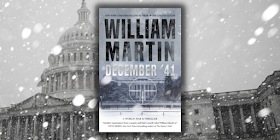WILLIAM MARTIN: December ’41: Starting a Historical Thriller
You never know where the idea will come from. It may be a story you heard in childhood. It may be a good opening sentence that you jot down, just to see how it sounds, and it prompts a second sentence and a third and suddenly you’re rolling. Or maybe you’re at the movies when the idea strikes.
That was how it happened for me with December ’41.
I was in a crowded Boston theater over Christmas, 2017. I was watching Darkest Hour, the story of Churchill in the spring of 1940. Halfway through, Churchill calls FDR to beg for help. France is falling to the Nazis. The British Expeditionary Force is retreating to Dunkirk. But FDR can offer only encouragement. American neutrality ties his hands. Churchill slumps in despair.
As we cut to a long shot of Churchill alone in a dark corner of his underground headquarters, I remembered that eighteen months later, Pearl Harbor would change everything. On the night of December 7, as Churchill wrote, he would “sleep the sleep of the saved and thankful.” He would soon travel to Washington to discuss strategy with FDR. And on Christmas Eve, they would stand together on the south portico of the White House to light the National Christmas Tree.
And what a target they’d make. That thought flashed through my mind, and a plot sprang to life: a Nazi assassin will try to kill them both on that solemn Christmas Eve.
I knew from the beginning that I wanted to write something different from the generation-spanning multi-plot novel I’m known for. I wanted a tight structure and a short time span. I wanted the characters to be playing for the highest of stakes on one of the biggest stages in history. And I wanted to tell you from the jump where I’d be taking you, then speed you inevitably toward that climax.
That’s what a good thriller is supposed to do. As author Steve Berry says, “A mystery is about what has happened. A thriller is about what’s going to happen.” And a historical thriller, which is subject to the basic rules of good thriller-writing, also has all that history to contend with. But history can provide the incidents that are the raw material for the scenes that are the building blocks of plot.
I try never to change history or make historical figures act as they wouldn’t have. I always try to remain faithful to the spirit of the facts if not the letter. And I know that nobody squeezed off a shot at FDR or Churchill on that Christmas Eve. But was anyone worried about the possibility? To find out, I turned to one of the experts, Mike Reilly, FDR’s Secret Service chief. In 1946, he wrote a now-forgotten memoir called Reilly of the White House, in which he described those early days, when the U.S. Army worried about paramilitaries attacking the White House. Reilly’s greatest fear was the lone assassin or the small group dispatched to kill the president.
It could’ve happened. So my plot premise was solid.
And I’d already decided to start the book in Los Angeles, because I’d always been fascinated by the L.A. of that era, a pro-fascist hotbed.
I’d even saved a magazine story about a Nazi compound in a canyon on the west side of town. It was known as the Murphy Ranch (even though it wasn’t a ranch and there was no Murphy). It had provided members of the L.A. German Bund and other fascist groups with a nice little hideaway where they could gather, train, shoot targets, and plan for something called der tag, or the day, as I would write, “when they’d rise up, get rid of all the Jews, and give Hitler a great big down home Hollywood welcome.” They’d even authorized plans for a 40-room mansion that some people thought would be Hitler’s Western White House. Crazy stuff, but true.
So the next time we visited L.A., we explored this location, an eerie place with graffiti-covered fuel and water tanks, power house, long concrete stairways down from the fire road, and garden terraces for self-sufficient living. As we wandered, I imagined the ghosts, the uniformed guards, the strutting fascists of the Silver Legion or the Bund. I could even see a terrific opening scene when the FBI raids the compound shortly after Pearl Harbor.
But how would this kick the plot into action?
What if our assassin is shooting at targets, a last round of practice before he fires the fateful shot. What if he escapes the FBI raid but leaves behind a tiny bit of evidence?
The manhunt is on, and the novel starts speeding down its track. It will carry us from Hollywood watering holes to the luxurious Santa Fe Super Chief to Washington DC. It will show us a nation awakening from isolation, from the pleasant distractions of swing music and movies, to confront the reality of war? It will depict ordinary Americans – an FBI agent, a Hollywood script reader, a failed actress, a detective, a train porter – meeting their moment in history, stepping out of their personal lives to stop that assassin and, perhaps, save the world.
How will they do it? Who will live and who will die? How close will the killer get to success? Answering those questions, building suspense in the face of historical fact, excited me during the process of writing and will keep readers excited until they reach the final page.
***
William Martin is the New York Times bestselling author of twelve novels, an award-winning PBS documentary, book reviews, magazine articles, and a cult-classic horror movie, too. Across a career now in its fifth decade, his books have brought American history to fictional life. The Providence Journal has called him “the King of the historical thriller.” He lives outside Boston. www.WilliamMartinBooks.com


No comments:
Post a Comment